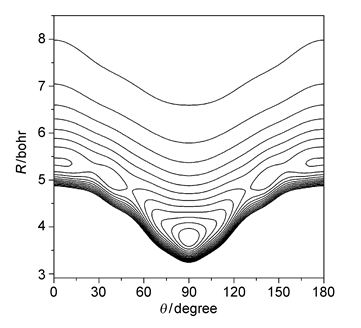| [1] Steed, J. M.; Dixion, T. A.; Klemperer, W. J. Chem. Phys. 1979, 70, 4095.
[2] Randall, R. W.; Walsh, M. A.; Howard, B. J. Faraday Discuss. Chem. Soc. 1988, 85, 13.
[3] Fraser, G. T.; Pine, A. S.; Suenram, R. D. J. Chem. Phys. 1988, 88, 6157.
[4] Pine, A. S.; Fraser, G. T. J. Chem. Phys. 1988, 89, 100.
[5] Iida, M.; Ohsbima, Y.; Endo, Y. J. Phys. Chem. 1993, 97, 357.
[6] Weida, M. J.; Sperhac, J. M.; Nesbitt, D. J. J. Chem. Phys. 1994, 101, 8351.
[7] Xu, Y. J.; Jäger, W. J. Mol. Spectrosc. 1998, 192, 435.
[8] Xu, Y.; Jager, W. J. Mol. Struct. 2001, 559, 211.
[9] Thievin, J.; Cadudal, Y.; Georges, R.; Vigasin, A. A. J. Mol. Spectrosc. 2006, 240, 141.
[10] Konno, T.; Fukuda, S.; Ozaki, Y. Chem. Phys. Lett. 2005, 414, 331.
[11] Konno, T.; Fukuda, S.; Ozaki, Y. Chem. Phys. Lett. 2006, 421, 421.
[12] Parker, G. A.; Snow, R. L.; Pack, R. T. J. Chem. Phys. 1976, 64, 1668.
[13] Parker, G. A.; Keil, M.; Kuppermann, A. J. Chem. Phys. 1983, 78, 1145.
[14] Keil, M.; Parker, G. A. J. Chem. Phys. 1985, 82, 1947.
[15] Beneventi, L.; Casavecchia, P.; Vecchiocattivi, F.; Volpi, G. G.; Buck, U.; Lauenstein, C.; Schinke, R. J. Chem. Phys. 1988, 89, 4671.
[16] Roche, C. F.; Ernesti, A.; Huston, J. M.; Dickinson, A. S. J. Chem. Phys. 1996, 104, 2156.
[17] Hutson, J. M.; Ernesti, A. M.; Law, M.; Roche, C. F.; Wheatley, R. J. J. Chem. Phys. 1996, 105, 9130.
[18] Yan, G. S.; Yang, M. H.; Xie, D. Q. J. Chem. Phys. 1998, 109, 10284.
[19] Negri, F.; Ancliotto, F.; Mistura, G.; Toigo, F. J. Chem. Phys. 1999, 111, 6439.
[20] Marshall, P. J.; Szczesniak, M. M.; Sadlej, J.; Chalasinski, G.; ter Horst, M. A.; Jameson, C. J. J. Chem. Phys. 1996, 104, 6569.
[21] Ran, H.; Xie, D. Q. J. Chem. Phys. 2008, 128, 124323.
[22] Cui, Y. L.; Ran, H.; Xie, D. Q. J. Chem. Phys. 2009, 130, 224311.
[23] Chen, R.; Jiao, E. Q.; Zhu, H.; Xie, D. Q. J. Chem. Phys. 2010, 133, 104302.
[24] Chen, R.; Zhu, H. J. Theor. Comput. Chem. 2012, 11, 1175.
[25] Yan, G. S.; Xie, J. K.; Xie, D. Q. Acta Chim. Sinica 1997, 55, 1041. (鄢国森, 谢军楷, 谢代前, 化学学报, 1997, 55, 1041)
[26] Lu, Y. H.; Zhou, Y. Z.; Xie, D. Q.; Yan, G. S. Acta Chim. Sinica 2000, 58, 1516. (卢语晖, 周燕子, 谢代前, 鄢国森, 化学学报, 2000, 58, 1516)
[27] Ran, H.; Zhou, Y. Z.; Xie, D. Q. Int. Rev. Phys. Chem. 2007, 26, 487.
[28] Mivehvar, F.; Lauzin, C.; McKellar, A. R. W.; Moazzen-Ahmadi, N. J. Mol. Spectrosc. 2012, 281, 24.
[29] Farrokhpour, H.; Tozihi, M. Mol. Phys. 2013, 111, 779.
[30] Zang, L. M.; Dai, W.; Zheng, L. M.; Duan, C. X.; Lu, Y. P.; Yang, M. H. J. Chem. Phys. 2014, 140, 114310.
[31] Yuan, T.; Sun, X. L.; Hu, Y.; Zhu, H. J. Chem. Phys. 2014, 141, 104306.
[32] Hu, Y.; Yuan, T.; Zhu, H. Comput. Theor. Chem. 2015, 47, 1056.
[33] Yuan, T.; Yang, M. L.; Zhu, H. Comput. Theor. Chem. 2015, 88, 1070.
[34] Shang, J.; Yuan, T.; Zhu, H. Theor. Chem. Acc. 2016, 135, 1.
[35] Shang, J.; Yuan, T.; Zhu, H. Chem. Phys. Lett. 2016, 648, 147.
[36] Wei, H.; Carrington, T. J. Chem. Phys. 1992, 97, 3029.
[37] Echave, J.; Clary, D. C. Chem. Phys. Lett. 1992, 190, 225.
[38] Wells, J. S.; Schneider, M.; Maki, A. G. J. Mol. Spectrosc. 1988, 132, 422.
[39] Werner, H. J.; Knowles, P. J.; Amos, R. D.; Berning, A.; Cooper, D. L.; Deegan, M. J. O.; Dobbyn, A. J.; Eckert, F.; Elbert, S. T.; Hampel, C.; Lindh, R.; Lloyd, A. W.; Meyer, W.; Nicklass, A.; Peterson, K.; Pitzer, R.; Stone, A. J.; Taylor, P. R.; Mura, M. E.; Pulay, P.; Schutz, M.; Stoll, H.; Thoorstcinsso, T. MOLPRO, version 2000.1, a package of ab initio programs 2000, see http://www.molpro.net
[40] Adler, T. B.; Knizia, G.; Werner, H. J. J. Chem. Phys. 1992, 127, 221106.
[41] Knizia, G.; Adler, T. B.; Werner, H. J. J. Chem. Phys. 2009, 130, 054104.
[42] Woon, D. E.; Dunning, T. H. J. Chem. Phys. 1993, 98, 1358.
[43] Peterson, K. A.; Figgen, D.; Goll, E.; Stoll, H.; Dolg, M. J. Chem. Phys. 2003, 119, 11113.
[44] Pedersen, T. B.; Fernandez, B.; Koch, H.; Makarewicz, J. J. Chem. Phys. 2001, 115, 8431.
[45] Boys, S. F.; Bernardi, F. Mol. Phys. 1970, 19, 553.
[46] Tennyson, J.; Sutcliffe, B. T. Mol. Phys. 1984, 51, 887.
[47] Miller, S.; Tennyson, J. J. Mol. Spectrosc. 1988, 128, 132530.
[48] Lin, S. Y.; Guo, H. J. Chem. Phys. 2002, 117, 5183.
[49] Chen, R. Q.; Ma, G. B.; Guo, H. Chem. Phys. Lett. 2000, 320, 567.
[50] Colbert, D. T.; Miller, W. H. J. Chem. Phys. 1992, 96, 1982.
[51] Lanczos, C. J. Res. Natl. Bur. Stand. 1950, 45, 255.
[52] Yu, H. G. J. Chem. Phys. 2002, 117, 8190.
[53] Watson, J. K. G. J. Chem. Phys. 1967, 46, 1935.
[54] Qin, M.; Shang, J.; Hong, Q.; Zhu, H. Mol. Phys. 2017, 115, 379. |
